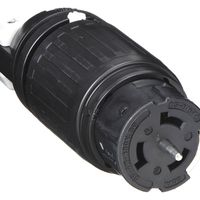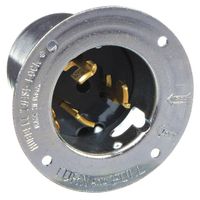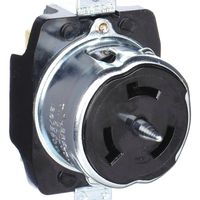Call +(254) 703 030 000 / 751 483 999 / 721 704 777
- Home
- Electrical
- Electrical Connectors Wiring Devices
- Plugs Receptacles Wiring Devices
- Non Nema Locking Blade Plugs Receptacles
.....Read More
Frequently Asked Questions
What are Non-NEMA locking-blade plugs and receptacles?
Non-NEMA locking-blade plugs and receptacles are electrical connectors that do not conform to the standards set by the National Electrical Manufacturers Association (NEMA). These connectors are designed to provide a secure connection by using a locking mechanism that prevents accidental disconnection. Unlike standard NEMA configurations, which are widely used in North America and have specific designations for voltage, current, and configuration, non-NEMA locking devices are often used in specialized applications where unique configurations are required.
These connectors are typically used in industrial, commercial, and specialized environments where equipment needs to remain securely connected under conditions that might cause standard plugs to disconnect. The locking mechanism usually involves twisting the plug after insertion, which engages the locking feature and ensures a firm connection.
Non-NEMA locking-blade plugs and receptacles can be customized to meet specific requirements, such as different voltage ratings, current capacities, and environmental conditions. They are often used in applications like stage lighting, marine environments, and other areas where equipment is subject to movement or vibration.
Because they do not adhere to NEMA standards, these connectors may not be interchangeable with NEMA devices, and their use is typically dictated by the specific needs of the application. They are often chosen for their durability, reliability, and ability to maintain a secure connection in challenging conditions.
How do Non-NEMA plugs and receptacles differ from NEMA standards?
Non-NEMA plugs and receptacles differ from NEMA standards primarily in design, application, and regional usage. NEMA (National Electrical Manufacturers Association) standards are specific to North America and define configurations for electrical plugs and receptacles, ensuring compatibility and safety across devices and installations. These standards specify voltage, current capacity, grounding, and pin configuration.
Non-NEMA plugs and receptacles, on the other hand, are used in regions outside North America and follow different standards, such as IEC (International Electrotechnical Commission), BS (British Standards), or CEE (Commission for European Electrotechnical Standardization). These standards cater to different voltage levels, frequencies, and safety requirements prevalent in those regions.
Design differences are notable: NEMA plugs typically have flat blades, while non-NEMA plugs may have round pins or a combination of shapes. The pin configuration and size can vary significantly, affecting compatibility with sockets. For instance, the UK uses a three-pin rectangular configuration (BS 1363), while much of Europe uses a two-pin round configuration (CEE 7/16 or CEE 7/7).
Non-NEMA standards often incorporate additional safety features, such as shutters on sockets to prevent accidental contact, which are not always present in NEMA designs. Furthermore, non-NEMA systems may support different grounding methods and polarization, affecting how devices are connected to the electrical grid.
In summary, the primary differences lie in regional applicability, design, and safety features, with each system tailored to meet the specific electrical infrastructure and safety regulations of its respective region.
What are the applications of Non-NEMA locking-blade devices?
Non-NEMA locking-blade devices are used in various applications where secure electrical connections are critical. These devices are often employed in industrial and commercial settings due to their ability to prevent accidental disconnection, which can lead to equipment downtime or safety hazards.
1. **Industrial Machinery**: Non-NEMA locking devices are commonly used in factories and manufacturing plants to connect heavy machinery and equipment. The locking mechanism ensures that the power supply remains stable during operation, even in environments with vibrations or movement.
2. **Data Centers**: In data centers, where uninterrupted power is crucial, these devices help maintain reliable connections for servers and networking equipment. The locking feature prevents accidental unplugging during maintenance or equipment rearrangement.
3. **Construction Sites**: On construction sites, where power tools and temporary lighting are frequently moved, non-NEMA locking devices provide a secure connection that withstands the rigors of a dynamic work environment.
4. **Entertainment Industry**: In the entertainment industry, particularly in stage and film production, these devices are used to connect lighting, sound, and special effects equipment. The locking mechanism ensures that connections remain intact during performances or filming.
5. **Marine and Outdoor Applications**: Non-NEMA locking devices are suitable for marine environments and outdoor applications where exposure to moisture and movement is common. They provide a secure and weather-resistant connection for equipment on boats or outdoor installations.
6. **Healthcare Facilities**: In hospitals and medical facilities, these devices are used to connect critical medical equipment, ensuring that life-saving devices remain powered without risk of accidental disconnection.
Overall, non-NEMA locking-blade devices are essential in any setting where a secure, reliable electrical connection is necessary to maintain safety, efficiency, and operational continuity.
How do you install Non-NEMA plugs and receptacles?
1. **Turn Off Power**: Switch off the circuit breaker to the outlet you are working on to ensure safety.
2. **Select the Right Plug and Receptacle**: Choose a non-NEMA plug and receptacle that match the voltage and amperage requirements of your device.
3. **Prepare the Wires**: Strip about 3/4 inch of insulation from the ends of the wires using a wire stripper.
4. **Connect the Wires to the Plug**:
- Open the plug casing.
- Connect the green or bare wire to the ground terminal (usually green).
- Connect the white wire (neutral) to the silver terminal.
- Connect the black wire (hot) to the brass or gold terminal.
- Secure the wires under the terminal screws and tighten them.
- Reassemble the plug casing.
5. **Install the Receptacle**:
- Remove the existing receptacle if necessary.
- Connect the ground wire to the green ground screw on the receptacle.
- Connect the neutral wire to the silver terminal.
- Connect the hot wire to the brass or gold terminal.
- Secure the receptacle into the electrical box with screws.
6. **Test the Connections**: Use a multimeter to ensure the connections are correct and there are no shorts.
7. **Secure the Cover Plate**: Attach the cover plate over the receptacle.
8. **Restore Power**: Turn the circuit breaker back on and test the plug and receptacle with the device to ensure proper operation.
What safety features do Non-NEMA locking-blade devices offer?
Non-NEMA locking-blade devices offer several safety features designed to enhance electrical connection security and prevent accidental disconnection. These features include:
1. **Locking Mechanism**: The primary safety feature is the locking mechanism that ensures a secure connection between the plug and receptacle. This prevents accidental unplugging due to vibrations or tension on the cord, which is crucial in industrial and commercial settings.
2. **Durability**: Non-NEMA locking devices are typically constructed from robust materials that can withstand harsh environments, reducing the risk of damage that could lead to electrical hazards.
3. **Weather Resistance**: Many of these devices are designed to be weather-resistant, providing protection against moisture, dust, and other environmental factors that could compromise electrical safety.
4. **High Amperage and Voltage Ratings**: They often support higher amperage and voltage ratings, ensuring safe operation of heavy-duty equipment without the risk of overheating or electrical failure.
5. **Color Coding and Keying**: These devices often feature color coding and unique keying to prevent mismatching connections, ensuring that only compatible devices are connected, which reduces the risk of electrical faults.
6. **Thermal Protection**: Some models include thermal protection features that prevent overheating by disconnecting the power if the device reaches unsafe temperatures.
7. **Corrosion Resistance**: The materials used are often resistant to corrosion, which is essential for maintaining electrical integrity over time, especially in corrosive environments.
8. **Secure Wiring**: They provide secure wiring connections that minimize the risk of loose wires, which can lead to short circuits or electrical fires.
These features collectively enhance the safety and reliability of electrical connections in demanding applications, reducing the risk of accidents and equipment damage.
Can Non-NEMA plugs be used with NEMA receptacles?
No, non-NEMA plugs should not be used with NEMA receptacles. NEMA (National Electrical Manufacturers Association) standards are designed to ensure compatibility, safety, and reliability in electrical connections. NEMA plugs and receptacles are specifically designed to match each other in terms of voltage, current capacity, and configuration. Using a non-NEMA plug with a NEMA receptacle can lead to several issues:
1. **Compatibility**: Non-NEMA plugs may not physically fit into NEMA receptacles due to differences in pin configuration, size, and shape. This can prevent a secure connection.
2. **Safety**: Mismatched plugs and receptacles can lead to poor electrical contact, increasing the risk of overheating, arcing, or electrical fires. Non-NEMA plugs may not be rated for the same voltage or current as the NEMA receptacle, leading to potential overloading.
3. **Standards Compliance**: NEMA standards ensure that electrical devices meet specific safety and performance criteria. Using non-NEMA plugs can violate these standards, potentially voiding warranties and failing to meet electrical codes.
4. **Functionality**: Non-NEMA plugs may not provide the necessary grounding or polarization, which are critical for the safe operation of many electrical devices.
5. **Legal and Insurance Issues**: Using non-standard electrical components can lead to non-compliance with local electrical codes, which may have legal implications and affect insurance coverage in the event of an electrical incident.
For these reasons, it is essential to use plugs and receptacles that are designed to work together according to NEMA standards. If a device has a non-NEMA plug, it is advisable to use an appropriate adapter or replace the plug with a NEMA-compliant one, ensuring it is done by a qualified professional.
Where can I purchase Non-NEMA locking-blade plugs and receptacles?
You can purchase Non-NEMA locking-blade plugs and receptacles from the following sources:
1. **Electrical Supply Stores**: Specialized electrical supply stores often carry a wide range of non-standard electrical components, including Non-NEMA locking-blade plugs and receptacles. Examples include Graybar, Rexel, and City Electric Supply.
2. **Online Retailers**: Websites like Amazon, eBay, and Alibaba offer a variety of Non-NEMA locking-blade plugs and receptacles. These platforms provide options from multiple sellers, allowing for price comparison and customer reviews.
3. **Manufacturer Websites**: Companies that specialize in electrical components, such as Hubbell, Leviton, and Eaton, often sell directly through their websites. They may offer detailed product specifications and customer support.
4. **Industrial Suppliers**: Suppliers like Grainger, McMaster-Carr, and MSC Industrial Supply cater to industrial needs and typically stock a range of specialized electrical components, including Non-NEMA plugs and receptacles.
5. **Local Hardware Stores**: Some local hardware stores may carry these items or can special order them for you. It's worth checking with stores like Home Depot or Lowe's, although their selection may be limited.
6. **Electrical Contractors**: If you are working with an electrical contractor, they may have access to specialized suppliers and can procure these components for you.
7. **Trade Shows and Expos**: Attending electrical trade shows or expos can provide opportunities to purchase directly from manufacturers or distributors.
8. **Wholesale Distributors**: Companies like Anixter and Wesco distribute electrical components and may offer wholesale pricing for bulk purchases.
Ensure to verify the specifications and compatibility of the plugs and receptacles with your equipment before purchasing.



